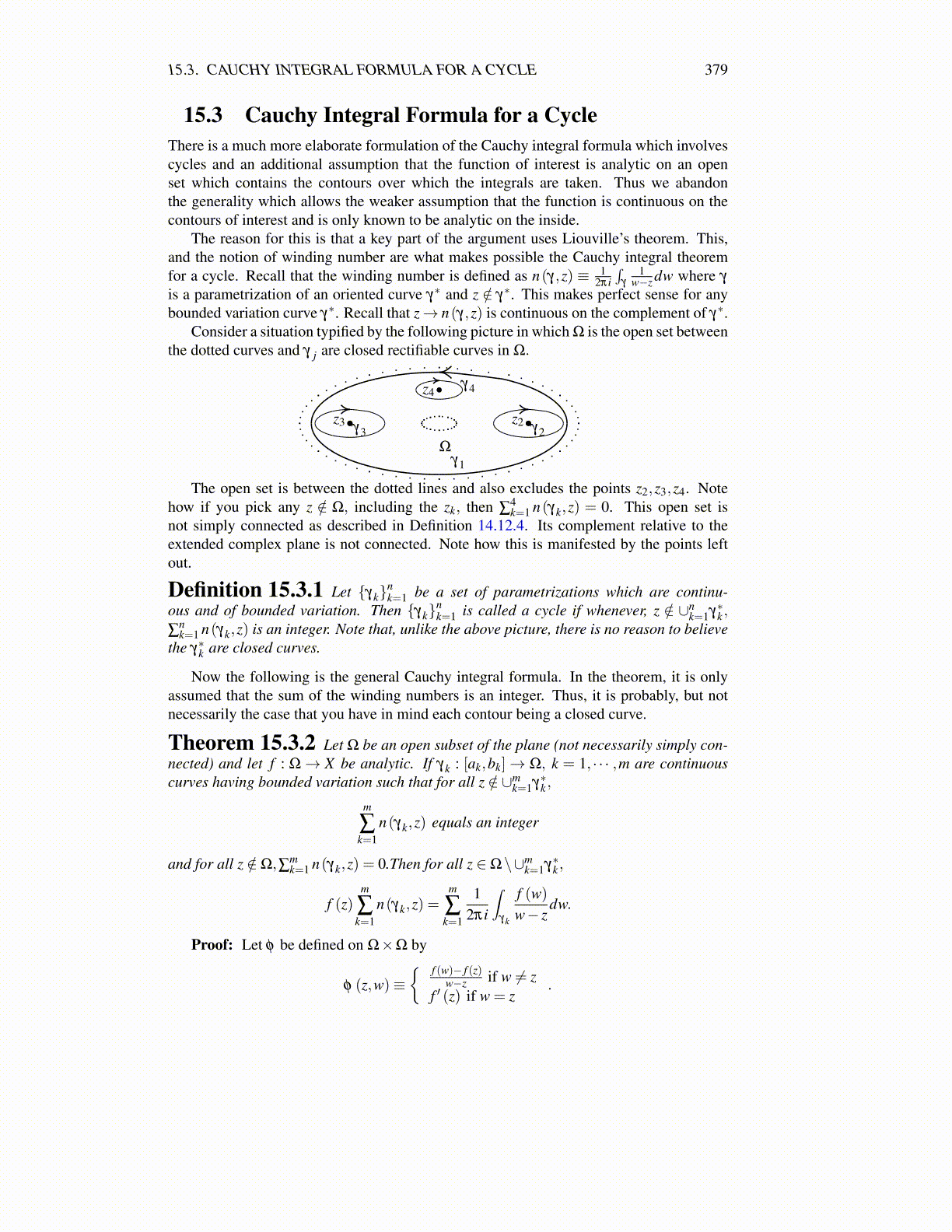
15.3. CAUCHY INTEGRAL FORMULA FOR A CYCLE 379
15.3 Cauchy Integral Formula for a CycleThere is a much more elaborate formulation of the Cauchy integral formula which involvescycles and an additional assumption that the function of interest is analytic on an openset which contains the contours over which the integrals are taken. Thus we abandonthe generality which allows the weaker assumption that the function is continuous on thecontours of interest and is only known to be analytic on the inside.
The reason for this is that a key part of the argument uses Liouville’s theorem. This,and the notion of winding number are what makes possible the Cauchy integral theoremfor a cycle. Recall that the winding number is defined as n(γ,z) ≡ 1
2πi∫
γ1
w−z dw where γ
is a parametrization of an oriented curve γ∗ and z /∈ γ∗. This makes perfect sense for anybounded variation curve γ∗. Recall that z→ n(γ,z) is continuous on the complement of γ∗.
Consider a situation typified by the following picture in which Ω is the open set betweenthe dotted curves and γ j are closed rectifiable curves in Ω.
γ2z2
γ3z3
γ4z4
Ωγ1
The open set is between the dotted lines and also excludes the points z2,z3,z4. Notehow if you pick any z /∈ Ω, including the zk, then ∑
4k=1 n(γk,z) = 0. This open set is
not simply connected as described in Definition 14.12.4. Its complement relative to theextended complex plane is not connected. Note how this is manifested by the points leftout.
Definition 15.3.1 Let {γk}nk=1 be a set of parametrizations which are continu-
ous and of bounded variation. Then {γk}nk=1 is called a cycle if whenever, z /∈ ∪n
k=1γ∗k ,
∑nk=1 n(γk,z) is an integer. Note that, unlike the above picture, there is no reason to believe
the γ∗k are closed curves.
Now the following is the general Cauchy integral formula. In the theorem, it is onlyassumed that the sum of the winding numbers is an integer. Thus, it is probably, but notnecessarily the case that you have in mind each contour being a closed curve.
Theorem 15.3.2 Let Ω be an open subset of the plane (not necessarily simply con-nected) and let f : Ω→ X be analytic. If γk : [ak,bk]→ Ω, k = 1, · · · ,m are continuouscurves having bounded variation such that for all z /∈ ∪m
k=1γ∗k ,
m
∑k=1
n(γk,z) equals an integer
and for all z /∈Ω,∑mk=1 n(γk,z) = 0.Then for all z ∈Ω\∪m
k=1γ∗k ,
f (z)m
∑k=1
n(γk,z) =m
∑k=1
12πi
∫γk
f (w)w− z
dw.
Proof: Let φ be defined on Ω×Ω by
φ (z,w)≡{ f (w)− f (z)
w−z if w ̸= zf ′ (z) if w = z
.